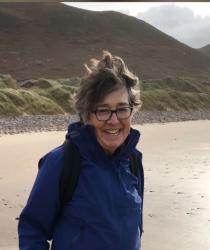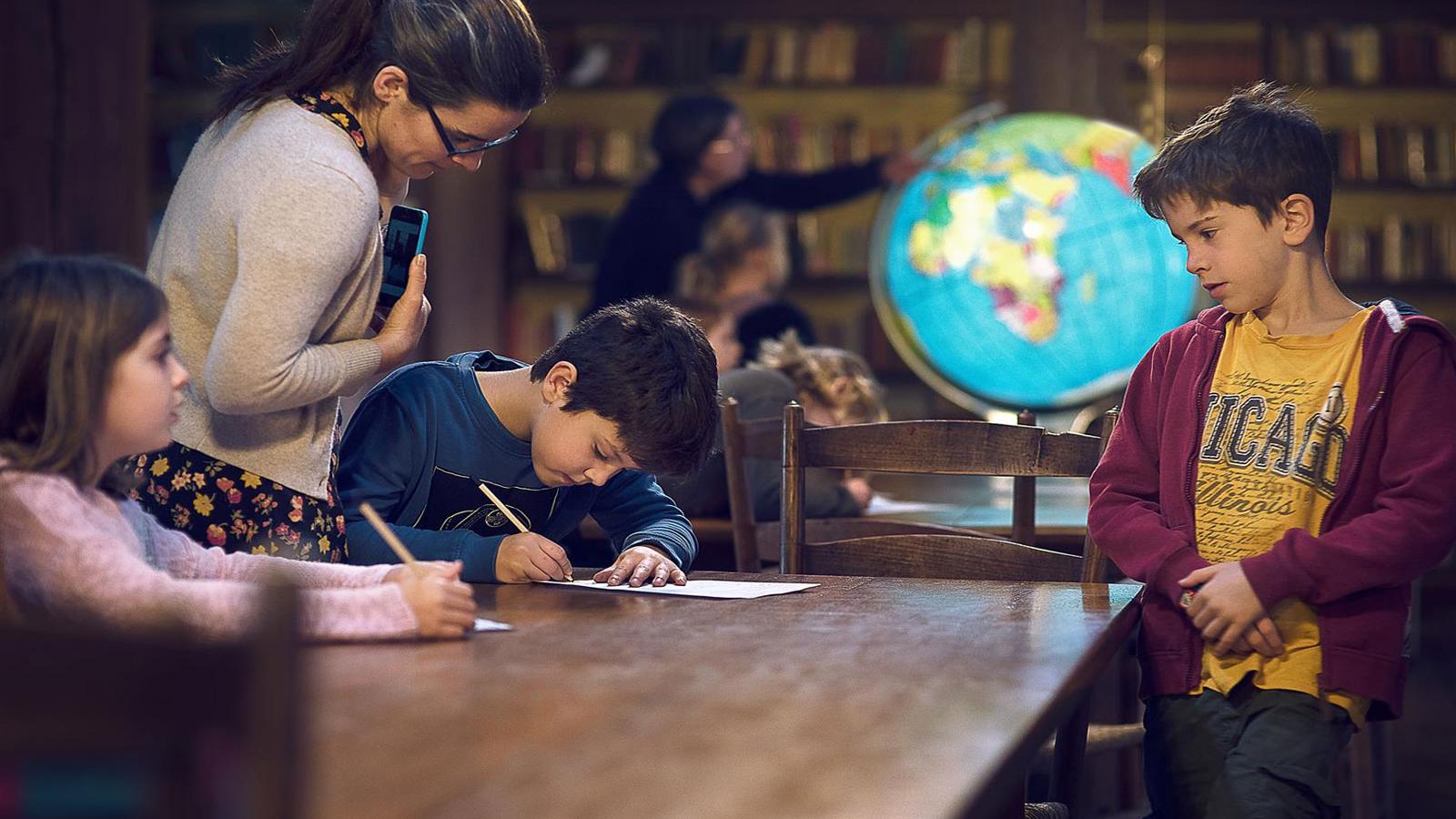
Alison Berman defies easy categorisation. She has fitted several careers into her working life: like many Bedalians she has ploughed her own creative furrow. Here she explains how she has finally become a successful artist and the role that Bedales may have played in that achievement.
Alison was sent to boarding school because her father’s career in the Royal Air Force involved postings overseas at unknown intervals. Her parents were determined that both their children should have an uninterrupted education and the best they could possibly afford. Her mother chose Bedales because she had been fascinated by the principles on which it was founded, ever since losing out on a scholarship at the Architectural Association to a boy from Bedales. She always had an instinct that it must be a special and unusual school.
Having lived in America between the ages of three and six, when the family came back to the UK, Alison found she had missed a whole chunk of basic education. She joined Halstead school in Woking, which she loved, but it suddenly had to close and after a term at Dunhurst, Alison was propelled into Block 3 at Bedales. Although she had visited a few times to see her older brother Martin, she still found Bedales a very scary place. “I always felt a bumpkin, in clothes my mother had made,” she says. “Being horribly self-conscious and shy it probably wasn’t the best thing to jump straight in to a Block where everyone else had been learning for a year, particularly as I had never studied Latin before! I really felt lost.”
In retrospect, Alison feels she joined Bedales at an uncomfortable time - almost as if the school was waiting for new direction towards the end of Hector Jack’s Headship. Tim Slack, who arrived in Alison’s last year at school, brought new energy, and this coincided with an awareness that other people existed outside the school gates. “We felt we were being quite radical in visiting old people in Steep and asking if they needed help. It was a time when Community Service Volunteers was a growing movement.”
“Unquestionably Bedales was chock full of beauty, set under beech woods on the Hangars with a breathtaking Library and music coming from every room.” Favourite places were the Barn, where Cor provided a refuge among looms ready set to weave tartan, and the Workshop where Biff gently taught skills to shape and solder metal. The art block was very intimidating - apart from a short period when there was a visiting pottery teacher. “I remember she encouraged me to use a wheel to throw a set of mugs. I had to go to the kitchens to weigh out the clay in equal chunks, but of course each one turned out entirely different! The outdoor work brigade had built a wood fired kiln, and it was thrilling feeding slivers of wood into the furnace in the middle of the night to reach the final soaring temperature for glaze.”
Despite describing herself as shy, Alison played significant theatrical roles at school - Perdita in Shakespeare’s Winter’s Tale and Helen of Troy in Jean Anouilh’s Tiger at the Gates. At weekends, she and her friends would go to the tea rooms in Petersfield for coffee and jap cakes or set off on long walks in the surrounding countryside. “We were not allowed to stay within the school grounds on Sunday afternoons, whatever the weather” Alison recalls. “My great friend Jean Robinson (daughter of Geoffrey who taught Maths and later became deputy Head) seemed to know every hedgerow and all about wildlife. She left school after the first year in 6.1 to train as a nurse. So did Karen Mills who went to Art College and I felt bereft.”
Among the teachers Alison remembers fondly, Harold Gardner and Rachel Cary Field are high on the list. “The fact that I’m now able to talk in front of an audience is almost entirely thanks to Rachel,” she says. “I think it was also very helpful that we were accustomed to shaking hands and looking people in the eye, as we had to at the end of every day after Assembly.” Alison was alone in trying to cover the syllabus for A level Botany and Zoology rather than Biology as one subject. She somehow believed she could pass English with very little preparation and failed all her exams spectacularly. However, retakes after a term at Brooklands Technical College with its superbly equipped labs was exciting. “It was a marvel to look down an electron microscope and actually see yeast dividing; and every afternoon to be able to draw cells on freshly stained slides which I had prepared.”
“At that stage, my ambition was to become a medical social worker or hospital almoner, as it was then known,” she says. “During nine months of my gap year, that ambition changed when I worked as an interviewer for National Opinion Polls meeting strangers and asking them how they would vote if there were to be an election next day. I was 17 or 18 and suddenly earning money - more in real terms than I’ve ever done since!“ She went to Leeds University to read sociology and from there to Liverpool on a three-year contract working mainly on race relations. “That prompted me to move on to Cardiff School of Architecture for a research project. I wanted to discover why people in cities like Liverpool were not being re-housed decently - and fast. Sadly, the Toxteth riots some years later didn’t come as a surprise.”
“While working as a sociologist in South Wales I met my first husband and we lived for a time on a Welsh smallholding before trying our hands (not very successfully) as dairy farmers in Cornwall. After we divorced, I decided to train as a nurse”, she says. “Qualifying as an SRN is something of which I am most proud. I married again and soon became pregnant with the first of my two children. There were plenty of nurses at that time in Oxford where we lived, but fewer teachers, so I gained yet another qualification - a PGCE. I so enjoyed teaching art and helping children to have confidence in using their imagination with paints and scrap materials that I started keeping a sketchbook and making small sculptures at home.” “A local artist, Paul Amey, saw some of my work and urged me to forget about full-time teaching and concentrate my efforts on sculpture. I am so grateful to him.”
“At some point, possibly at the end of a Foundation course in Art and Design at Abingdon and Witney College or when I put some large pieces of work on show in the dance studio at Oxford Playhouse, I asked one of my contemporaries from Bedales - Nina Shovelton - to come and see. She wasn’t able to travel, but looking at my website passed a recommendation to one of her daughter’s friends who was working at the renowned Hannah Peschar Sculpture Garden in Surrey. Hannah came specially to my studio and left with instructions: “I’d like to show that Dancing Dress, two Swaying Horses and three of those Deer!” It was a major breakthrough which suddenly gave credibility to someone who only had fine art qualifications up to Foundation level. Hannah continued to show my work at her wonderful sculpture garden until she retired. Thus the Bedales network via Nina gave me a huge lift.”
Over the past 15 years or so, Alison has developed her art in increasingly ambitious ways (see her website www.alisonberman.com). She works at different scales with almost any material which inspires her, from cement and clay to felted wool, found objects, metal, plaster, papier maché and non-toxic resins. The dynamic between sculpture and viewer is a main concern, and key to her work is the spirit of enquiry, experiment and exploration. “I am sure there are lots of OBs who have given all they can to the career they have taken on and as a side-line or in retirement have chosen to enjoy themselves with some artistic project,” she says. “I’ve simply had the gall to try and put what I have made on show. I’ve always needed a show or exhibition to provide a cut-off point without which I would be forever adding or taking away from a form: three steps forward, two steps back and maybe start all over again!” Alison’s work has been shown in fabulous outdoor settings such as Beaulieu, Doddington Hall, Avebury Manor, the Fresh Air Sculpture Show and at Hannah Peschar’s Sculpture Garden, as well as solo shows in a range of indoor venues in the UK and France. This year one of her jugs was selected to be part of the Royal Academy's Summer Exhibition on the theme of ‘Climate’.
“I’ve only felt able to call myself an artist very recently,” Alison says “It has been a long apprenticeship and in England especially, the business of being an artist can be a struggle: just getting an application accepted for studio space can be difficult, let alone being recognised - whereas in France I’ve found that if you say you are a sculptor, then you are immediately regarded as such. Luckily, I have a very supportive and encouraging husband, who is an architect and an artist in his own right. It is a wonderful life for me – I know that I’m a much nicer person when I’ve spent at least part of the day with materials and tools in my hands and a project in my head.”
It has been anything but a direct route to artistic prominence and has required a singular refusal to listen to conventional wisdom. “My father was a rather bloody-minded military officer who wouldn’t take no for an answer and I think I inherited some of that streak,” Alison confesses. “And yes, some of that stubbornness and willingness to experiment derives from Bedales, I’m sure.
Bedalians tend, I think, not to be so constrained by the need to fit in with convention.”
I would have been astonished if you’d told me as a teenager that I would be where I am now, but I can see that Bedales gave me a platform from which I could try to achieve anything.
Our friendship groups from those days have changed and expanded but we still love getting together. We have so much in common it’s easy to share and we continue to care for one another despite distance, perhaps because Bedales was both our home and our family for such a large part of the year. The emblem emblazoned on our Psalm books, with a rose and a bee - ‘Work of each for Weal of All’ - certainly holds true, as if also imprinted in our minds.”
Alison Berman was interviewed by James Fairweather in Summer 2022

